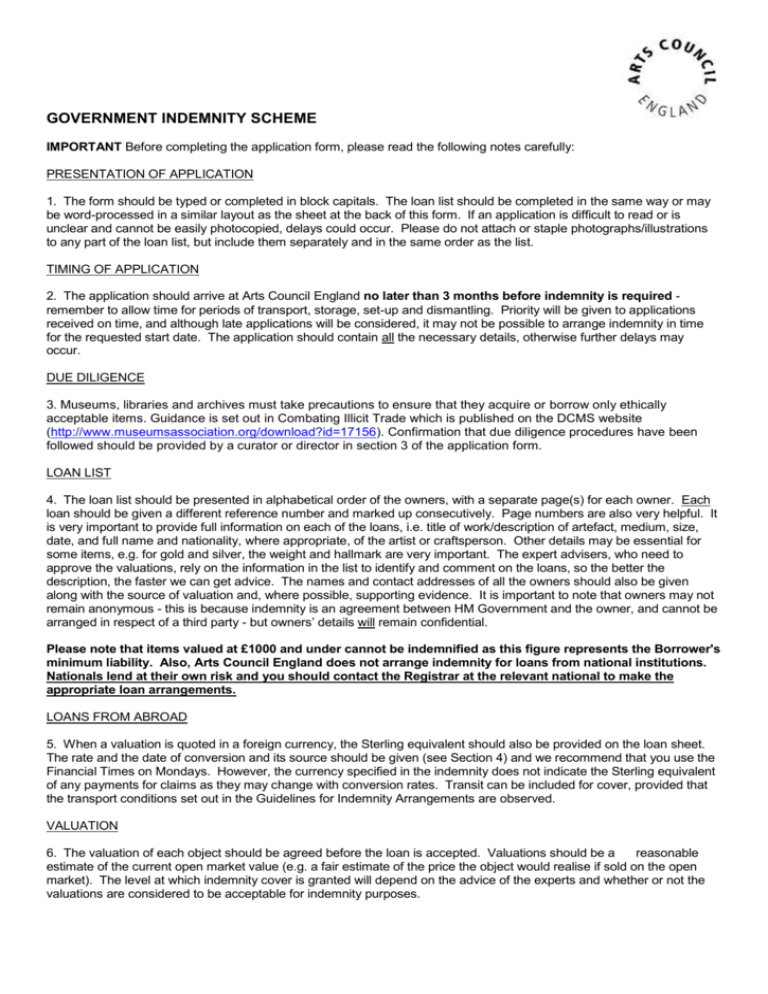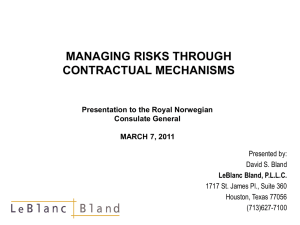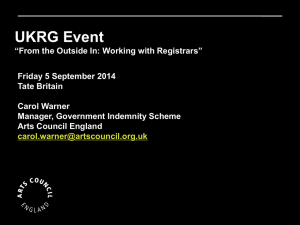- Arts Council England
advertisement

GOVERNMENT INDEMNITY SCHEME IMPORTANT Before completing the application form, please read the following notes carefully: PRESENTATION OF APPLICATION 1. The form should be typed or completed in block capitals. The loan list should be completed in the same way or may be word-processed in a similar layout as the sheet at the back of this form. If an application is difficult to read or is unclear and cannot be easily photocopied, delays could occur. Please do not attach or staple photographs/illustrations to any part of the loan list, but include them separately and in the same order as the list. TIMING OF APPLICATION 2. The application should arrive at Arts Council England no later than 3 months before indemnity is required remember to allow time for periods of transport, storage, set-up and dismantling. Priority will be given to applications received on time, and although late applications will be considered, it may not be possible to arrange indemnity in time for the requested start date. The application should contain all the necessary details, otherwise further delays may occur. DUE DILIGENCE 3. Museums, libraries and archives must take precautions to ensure that they acquire or borrow only ethically acceptable items. Guidance is set out in Combating Illicit Trade which is published on the DCMS website (http://www.museumsassociation.org/download?id=17156). Confirmation that due diligence procedures have been followed should be provided by a curator or director in section 3 of the application form. LOAN LIST 4. The loan list should be presented in alphabetical order of the owners, with a separate page(s) for each owner. Each loan should be given a different reference number and marked up consecutively. Page numbers are also very helpful. It is very important to provide full information on each of the loans, i.e. title of work/description of artefact, medium, size, date, and full name and nationality, where appropriate, of the artist or craftsperson. Other details may be essential for some items, e.g. for gold and silver, the weight and hallmark are very important. The expert advisers, who need to approve the valuations, rely on the information in the list to identify and comment on the loans, so the better the description, the faster we can get advice. The names and contact addresses of all the owners should also be given along with the source of valuation and, where possible, supporting evidence. It is important to note that owners may not remain anonymous - this is because indemnity is an agreement between HM Government and the owner, and cannot be arranged in respect of a third party - but owners’ details will remain confidential. Please note that items valued at £1000 and under cannot be indemnified as this figure represents the Borrower's minimum liability. Also, Arts Council England does not arrange indemnity for loans from national institutions. Nationals lend at their own risk and you should contact the Registrar at the relevant national to make the appropriate loan arrangements. LOANS FROM ABROAD 5. When a valuation is quoted in a foreign currency, the Sterling equivalent should also be provided on the loan sheet. The rate and the date of conversion and its source should be given (see Section 4) and we recommend that you use the Financial Times on Mondays. However, the currency specified in the indemnity does not indicate the Sterling equivalent of any payments for claims as they may change with conversion rates. Transit can be included for cover, provided that the transport conditions set out in the Guidelines for Indemnity Arrangements are observed. VALUATION 6. The valuation of each object should be agreed before the loan is accepted. Valuations should be a reasonable estimate of the current open market value (e.g. a fair estimate of the price the object would realise if sold on the open market). The level at which indemnity cover is granted will depend on the advice of the experts and whether or not the valuations are considered to be acceptable for indemnity purposes. ILLUSTRATIONS 7. Good quality illustrations or photographs are needed to send to the experts advising on valuations (for example faxed images are not adequate) and should be clearly cross-referenced with the loan list. They are required for all oil paintings valued at £60,000 and above, for works on paper (excluding photographs/posters) valued at £30,000 and above and for all other items, such as silver, textiles, sculpture and furniture, valued at £15,000 and above. If these cannot be supplied, there may be considerable delays. If a catalogue or other publication is used for illustrations, it should also be clearly cross-referenced with the loan list. MANUSCRIPTS & BOOKS 8. Extra information is needed to send to the experts advising on valuations for manuscripts and books. This is required for all items valued at £15,000 and above. Please provide the item’s shelf or reference mark, a colour image of the item, a description of the item, including the number of miniatures, borders, historiated initials, and illuminated initials (if any), and, if possible, the number of folios, measurements, provenance, date and origin. Please also provide a copy of the lending institution’s catalogue entry (if any) and a copy of the draft exhibition catalogue entry (if any). If these cannot be supplied, there may be considerable delays. If a catalogue entry or other publication is supplied, it should also be clearly cross-referenced with the loan list. ENVIRONMENTAL CONTROL 9. The environmental checklist should be completed in full and the supporting information emailed to the GIS team, government.indemnityscheme@artscouncil.org.uk. Arts Council England does not accept hard copies of environmental data. Arts Council England’s Environmental Adviser may ask for further information and it is possible that additional environmental conditions may be added to the terms and conditions of the offer of indemnity, particularly where fragile material is involved. If the borrower is aware of the fragility of an item, the relevant information should be provided. SECURITY 10. Details of security arrangements should be provided and the relevant information attached to the application. The National Security Adviser may ask for further information, especially if a new venue is involved, and additional conditions may, occasionally, be added to the terms and conditions of the offer of indemnity. TRAVELLING EXHIBITIONS 11. When an exhibition travels to more than one venue, each venue should apply separately for indemnity to cover the period of transport, storage and display for which it is responsible. Each venue should give Arts Council England full and accurate details of the loans and the dates of indemnity etc. Arts Council England does not wish to act as a go-between for the venue and the exhibition organiser. ELIGIBILITY 12. Under the terms of the National Heritage Act 1980, museums, galleries and libraries funded by local authorities or universities, are eligible for Government Indemnity. Other institutions may be approved as eligible for indemnity cover, but this is not automatic. Arts Council England seeks approval from HM Treasury and for this we need you to send us copies of your most recent audited accounts and constitutional documents. BORROWER'S UNDERTAKING 13. The Undertaking attached to this form should be signed on behalf of the borrowing institution to confirm that it will take responsibility for the minimum liability, and agrees to the general terms of indemnity. Without this signed Undertaking, arrangements for indemnity cover cannot be made. Arts Council England October 2016 GOVERNMENT INDEMNITY SCHEME APPLICATION FORM 1. BORROWER: (the institution that is taking responsibility for loans while on exhibition and in transit etc.) Name: Address: Telephone: E-mail: 2. TITLE OF EXHIBITION/LOAN: 3. DUE DILIGENCE Confirmation due diligence checks have been carried out to ensure only ethically acceptable items are borrowed Name: Job Title: Confirmation due diligence procedures have been followed should be given by a curator or director 4. TOTAL VALUE OF ITEMS TO BE COVERED: £ If loans are valued in foreign currency, please give an approximate Sterling equivalent, exchange rate used, source and date of exchange rate (please also see note under section 12) £ 5. TOTAL NUMBER OF ITEMS TO BE COVERED: 6. PERIOD OF INDEMNITY COVER:* From: / / To: / / Allow for periods of transit, storage, set-up and dismantling etc. *Indemnity for long-term loans is arranged for three years in the first instance but can subsequently be renewed for further three-year periods. 7. DISPLAY DATES: From: / / To: / / 8. DISPLAY AREA: Please specify the gallery/ies or space/s where indemnified loans will be displayed. If a different building to that specified in Section 1 above is to be used, please give details below Name: Address: Telephone: E-mail: 9. REASON FOR EXHIBITION/LOAN Please explain the significance of the exhibition/loan and how it will contribute to public understanding and appreciation. Please give a summary of the exhibition and, if possible, enclose copies of press releases or publicity. (Continue on a separate sheet if necessary.) 10. SECURITY ARRANGEMENTS In transit: In store (before and after public display): On display: Other relevant security information: 11. ENVIRONMENTAL CONTROL PROVISIONS Have you provided the following information? Please tick as appropriate. If YES, please attach the relevant information. If NO, please provide an explanation for its exclusion. Yes No N/A 1. In transit The transport vehicle has RH/T°C monitoring, RH/T°C control and air ride suspension. ☐ ☐ ☐ 2. Climate in storage Data for before the exhibition, after the exhibition and between venues (if on tour) are available. Please indicate if unpacking/packing takes place in display areas. ☐ ☐ ☐ 3. Light levels in store It is possible to extinguish all light in the store. (No information is required if unpacking/packing takes place in display areas.) ☐ ☐ ☐ 4. Climate on display i) Environmental readings are provided for the same period one year prior to the display period. ☐ ☐ ☐ ii) The minimum and maximum conditions for RH per week will be within the band 4065% with a maximum cycle of 10% within 24 hours, & temperature within the band 1624C with a maximum cycle of 4C within 24 hours. ☐ ☐ ☐ iii) Data loggers (if used, otherwise thermo hygrographs) set to record at 30 minute intervals round the clock. ☐ ☐ ☐ There may be good reason for not maintaining these conditions, if so please provide an explanation below: 5. Light levels on display Natural ☐ ☐ ☐ i) Electric ☐ ☐ ☐ A combination of both ☐ ☐ ☐ ii) It is at a level of 200 lux or below. (If not, please provide an explanation) ☐ ☐ ☐ iii) It is at a level of 50 lux or below. (If not, please provide an explanation) ☐ ☐ ☐ ☐ ☐ ☐ ☐ ☐ ☐ Blackout facilities exist ☐ ☐ ☐ Heat from light sources has been controlled ☐ ☐ ☐ iv) 6. The lighting is: Lux readings for the same period one year prior to the display period are provided with the application Please confirm that Sunlight and ultraviolet radiation has been excluded If the answer to any of these is 'no', please indicate below how potential problems might be overcome: 7. ☐ ☐ ☐ ii) Continuous monitoring is undertaken ☐ ☐ ☐ iii) Have you provided details of when the equipment was last calibrated? ☐ ☐ ☐ Glazed ☐ ☐ ☐ Backed ☐ ☐ ☐ Framed ☐ ☐ ☐ ☐ ☐ ☐ ☐ ☐ ☐ Methods of monitoring on display i)Spot monitoring is undertaken Please give details of the equipment used to monitor RH, TC, light & UV: 8. Methods of display during exhibition i) ii) iv) Works on canvas/paper/board/etc. are Will objects be placed on open display? Will objects be displayed in cases? Please provide separate details of cases and methods of monitoring within the cases: ANNOTATING ENVIRONMENTAL DATA GRAPHS (preferred format) 1. 2. 3. 4. 5. 6. 7. 8. 9. 10. 11. 12. Only email attachments of original data should be sent. Computerised logging of RH, TC, light and UV radiation should be presented on graphs. Relative humidity and temperature curves should be clearly labelled. Where curves cross over, they should be highlighted in different colours. On single-drum thermo hygrograph charts, where relative humidity and temperature charts may overlap, the time difference between the 2 curves should be marked on the chart. Data loggers should be set to record at 30-minute intervals round the clock The lowest and highest relative humidity values and the lowest and highest temperature values for the monitoring period as a whole, e.g. a week should be marked on the graph. A written explanation should be provided for cycles of more than 10% RH and 4C T during any 24-hour period. Light and UV radiation curves should be clearly identified. The highest light and UV radiation values for the monitoring period as a whole, e.g. a week should be marked on the graph. A written explanation should be provided for readings in excess of 200 lux. The start and end dates of the monitoring period should be written on the chart. The location where monitoring has taken place should be clearly stated. A sketch of the room with the monitoring location marked, including doors and windows, would be helpful. TABLES 1. 2. 3. 4. 5. 6. 7. 8. 9. 10. Only email attachments of original data should be sent. RH/T Tables, particularly computer-generated readings should be plotted as graphs wherever possible. Information as described above should then be provided. If RH/T Tables are provided, the information should be grouped under the following headings: Date and Time period, Lowest and Highest RH values, Lowest and Highest Temperature values. With RH/T Tables generated from spot-checks, readings at 9.00am, 12.00 noon, 3,00pm and 6.00pm should be taken and summarised into the highest and lowest readings for each day. With computer-generated Tables, data at 2-hourly intervals over the 24-hour period should be collected and summarised as described under 4. A written explanation should be provided for cycles of more than 10% RH and 4C T during any 24-hour period. If light and UV radiation Tables are provided, the information should be grouped under the following headings: Date, Time Period, Highest Light Value, Highest UV Radiation Value, and Weather Conditions. If daylight is used, readings should be taken at 3.00pm daily. If electric lighting only is used, weekly readings are sufficient. A written explanation should be provided for readings in excess of 200 lux. The start and end dates of the monitoring period should be written on the Table. The location where monitoring has taken place should be clearly stated. A sketch of the room with the monitoring location marked, including doors and windows, would be helpful. Please remember that only email attachments of environmental data should be submitted. Hard copies of data are not needed and should not be sent with your application. Annex B Undertaking for Non-national Institutions APPLICANT'S UNDERTAKING To: The Secretary of State In consideration of the giving by you of any undertaking to indemnify under section 16 of the National Heritage Act 1980 (or any statutory modification or re-enactment thereof) for the loss of, or damage to, any object belonging to an institution, body or person while on loan to us (hereinafter called ‘the object(s)’ or ‘object(s) loaned’), we hereby undertake: (i) to facilitate public access to the object(s) as detailed in our application or to examine, study or analyse the object(s) in such a way that this will contribute materially to public understanding or appreciation of the object(s), for example by using consequent results, findings or conclusions to enhance interpretation or explanation to the public of the object(s) or by bringing into the public domain the results, findings or conclusions; (ii) to manage, safeguard and care for the object(s) in the same manner that this institution would manage, safeguard and care for objects or items in its own collection(s) which are similar to the object(s) loaned; (iii) to provide a level of environmental control appropriate to the care of the indemnified objects, and to comply with any further arrangements which the Environmental Adviser to the Arts Council (hereinafter called ‘the Arts Council’) may recommend to us; (iv) to comply with the security, transport and food and wine conditions for the time being set out in Annexes D, E and F of the document entitled Government Indemnity Scheme – Guidelines for non-national institutions and any further such arrangements which the National Security Adviser of the Arts Council may recommend to us while the object(s) are on loan to us or while being taken to or returned from the place where the object(s) are to be or have been kept while on loan to us; (v) to scrutinise and assess valuations submitted by potential lenders so that valuations submitted to you are a fair estimate of the value that the object(s) to be indemnified might reach if sold on the open market at the time of the loan; (vi) to provide or procure the best possible evidence in the circumstance of the condition of the object(s) as received into our care and control, bearing in mind such factors as the value of the object(s) and its susceptibility to damage, the distance between our geographical situation and the object’s current location and the resources required to make a formal condition report and to make a record of the condition of the object(s) as received back out of our care and control and to forward such records (including any interim records) to you in the event of any claim; (vii) to meet the cost of any claim made under any section 16 undertaking up to a limit of a. £300 for each object which has a specified value under the indemnity of less than £4,000; or b. £300 plus 1% of the said specified value for each object which has a specified value under the indemnity of £4,000 or more; (viii) to notify the Arts Council immediately in writing of the loss of, or damage to, any of the indemnified objects, and of any proposed variation in the arrangements for public access, the security or transport arrangements or environmental control provisions adopted in relation to the objects loaned; (ix) to provide a condition report following any damage to any of the objects; (x) to take note of, and endeavour to comply with, any guidance issued by you to us in respect of borrowing by us of objects which are likely to be the subject of section 16 undertakings; and (xi) to take steps to confirm to the best of our knowledge that the owner(s) of the object(s) loaned has legal title to it and that such object(s) have not been wrongfully taken or illegally exported. (xii) to acknowledge the Government Indemnity Scheme by using the following wording in exhibition literature and in all credits: “This exhibition has been made possible as a result of the Government Indemnity Scheme. The [name of institution] would like to thank HM Government for providing Government Indemnity and the Department for Culture, Media and Sport and Arts Council England for arranging the indemnity.” For and on behalf of…………………………………………………………………. (being a person authorised to sign on that behalf) Signature: ............................................................................................................. Name: ................................................................................................................... Position held in institution: .................................................................................... Date: ...................................................................................................................... 11. LOANS – presentation of loan list LOAN LISTS SHOULD BE IN PORTRAIT FORMAT AND ALL LOANS SHOULD BE NUMBERED CONSECUTIVELY Please use the following page, attached, to list all loans which are to be indemnified. Continue on separate sheets if necessary. Alternatively, you may provide the list in your own format, provided this is printable and contains all the relevant information. A separate page is required for each owner. Please provide a reference number for each loan and mark them up consecutively. For example do not provide numbers 1, 2, 3 for each owner. If loans are still provisional, you should indicate this and follow up with firm details as soon as possible. If not, indemnity cover for these items may not be arranged on time. Please specify full name & address of each owner. Owners may not remain anonymous but their details will remain confidential. Do not include items valued at £1000 and under and/or items on loan from national institutions. 12. CONTACT AT BORROWING INSTITUTION (i.e. Who to contact for further information.) Name: Job role: Address: Telephone: E-mail: 13. PLEASE RETURN THE COMPLETED FORM No later than three months before the date from which indemnity is to begin, together with any attachments and enclosures, to: e-mail: government.indemnityscheme@artscouncil.org.uk Alternatively by post to: The GIS team Assistant, Government Indemnity Scheme Arts Council England 82 Granville Street Birmingham B1 2LH GOVERNMENT INDEMNITY SCHEME LIST OF ALL ITEMS FOR WHICH INDEMNITY COVER IS REQUIRED PROPERTY OF: FULL DESCRIPTION (Title, dimensions, medium and date) 1. 2. 3. 4. 5. ARTIST/CRAFTSMAN VALUATION (Please specify source and basis for figure. If valued in a foreign currency, please provide a Sterling Equivalent)








